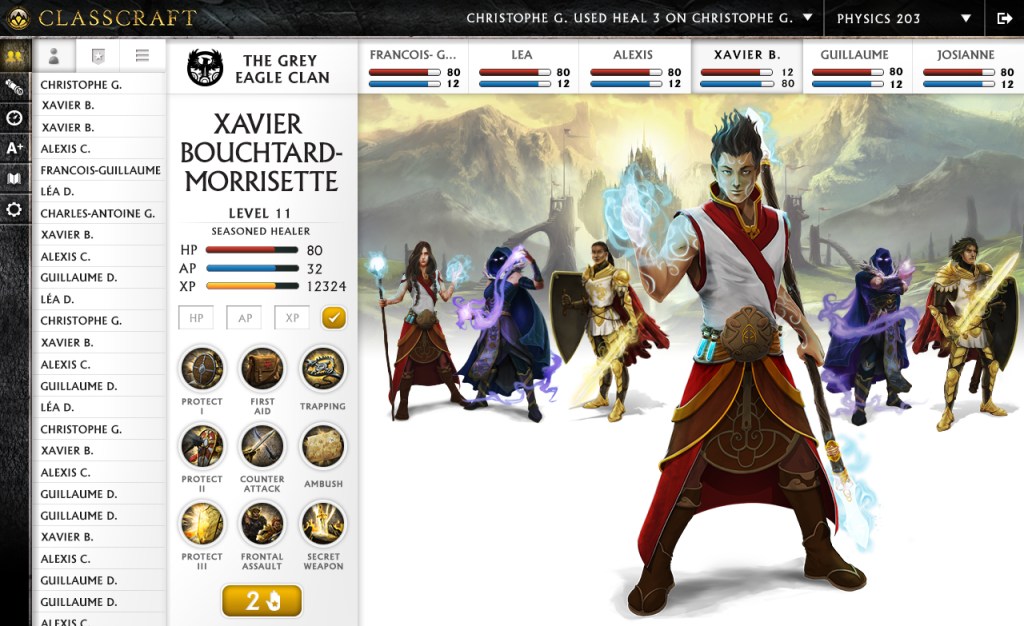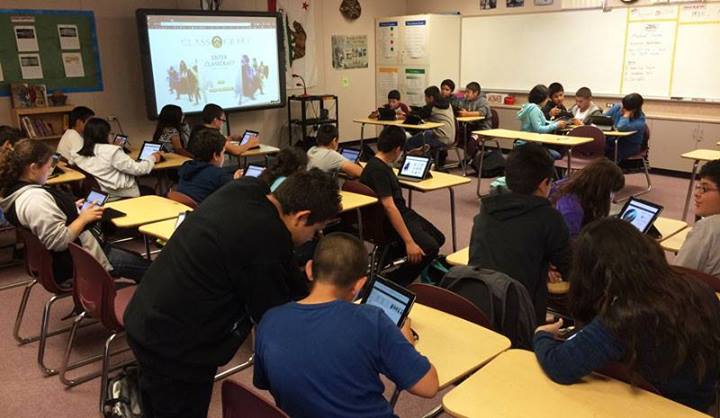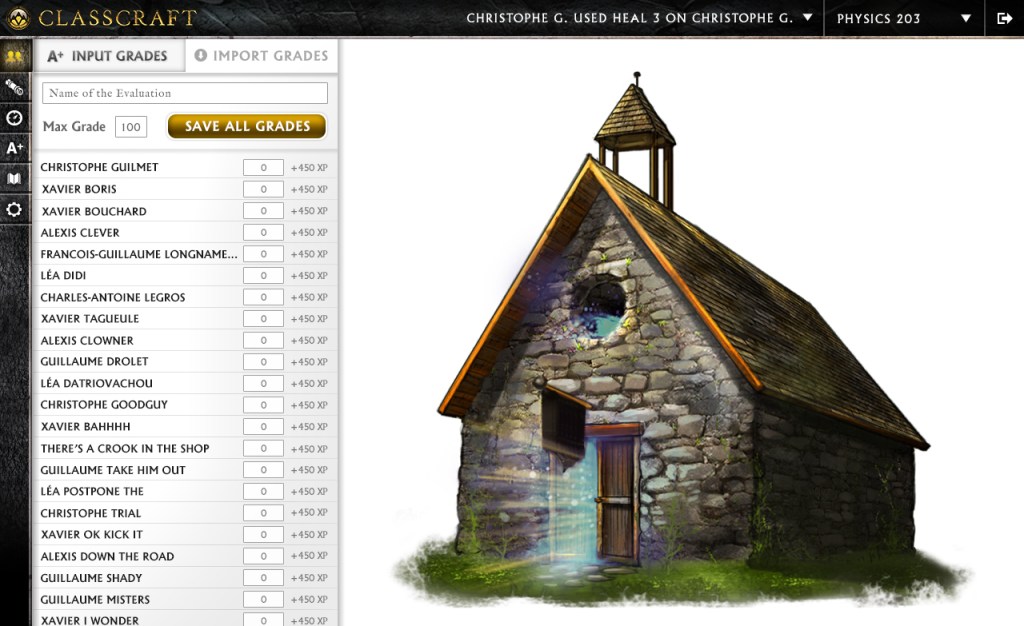Shawn Young has a class full of warriors, mages, and healers. Warriors get to eat in class, mages can teleport out of a lecture, and healers can ask if an exam answer is correct.
But this isn’t some Dungeons & Dragons-style fantasy. This is education as it’s happening for over 7,000 kids in more than 25 countries right now. Young, a high-school physics teacher, has been developing and refining Classcraft, his classroom-based role-playing game for the past three years, and he says it creates a collaborative and supportive learning environment that can help turn around students who are failing.
Currently a free service, Classcraft will introduce a pay structure this fall that embraces the free-to-play model more commonly seen in mobile apps and online games like League of Legends and Runescape. It’s going to turn heads in an education system used to strict budgets and paying per-head for software solutions, especially when they realize that the students will be buying gear and pets for their Classcraft avatars on iTunes.
Playing in class
If you’re a gamer, being in Shawn Young’s physics classroom sounds like a blast. At the start of class, his students come in and check their stats on the screen projected at the front of the room. When the bell rings, its time for a random event, which could impact one or more players. It might be a disaster, like a pupil’s game character dying, or it could be something goofy like someone getting up to sing.
AI Weekly
The must-read newsletter for AI and Big Data industry written by Khari Johnson, Kyle Wiggers, and Seth Colaner.
Included with VentureBeat Insider and VentureBeat VIP memberships.
This helps focus the students, Young told GamesBeat during a video call, as “the second they get into class, they want to know what’s going to happen.”
As the lesson progresses, Young will dish out experience points for good work and collaboration and will give hit damage to students who lack focus or misbehave. Students can gain powers specific to their character class by levelling up, and they can use these to help and protect their teammates (or themselves), activating them live as events that unfold in the classroom.
The teacher can track all this activity in Classcraft, or, as in Young’s case, the kids can use their laptops to interact with it in real-time. Come September, they’ll be able to use their smartphones to keep up with the game too, with an iOS app set for release and an Android version to follow.
Cutting class and eating chocolate
As the Game Master, Young’s students are playing by his rules, but the chance to turn things in their favor is always there. Some powers have potent individual and team effects, and the students can get pretty creative with them.
“There’s one power, Teleport, where you can leave the class for 2 minutes,” says Young, “so they’ll stack that and leave for 10 minutes. That kind of annoying, but at the same time it’s part of the game.”
Some kids also used the warrior’s power to eat in class as an excuse to bring in a chocolate fondue.
Young admits that the rewards on offer in Classcraft are often outside the normal rules of school, but he says that’s what makes them so appealing. “I’m like, OK, I’m cool — this is hilarious,” says Young. “It goes both ways. As the Games Master, you buy into that, [but] then when they die they get these horrible consequences.
“For them, their real life is going to school. And Classcraft is successful and significant because these rewards and punishments are significant for them.”
If a pupil’s hit points run out, they die. They then face a punishment that a roll of the die determines, which can include detention or copying out a five-page text.
“Typically, they’d be like, ‘Oh, you’re mean, you’re giving me detention,’ and try and get out of it,” says Young. “Now, they’re like, ‘This is the game, it’s cool, I’ll go.’ You don’t even need to check if they’re going. They’re definitely going.”
“Students don’t typically respond happily to punishments. But they are. It’s weird.”
Transforming the classroom through collaboration
Young had the Classcraft idea in his head for several years before acting on it.
Before making it, he tried various ways of getting kids to collaborate better in class, something he believes is important in a 21st century that’s proving a boom time for sharing, not least through social media.
“I did some other experiments before where kids would work in teams and get the worst grade of the four people in their team,” says Young. “It was a little too hardcore. [Laughs] A little too directly relating to their grades, so some of them felt it wasn’t fair.”
Going after that group mentality is key for Young, though, and he doesn’t think the education system values it enough. “Our whole system of [pupil] rewards is based on individual assessments,” he says, “and that’s not useful for them. What’s useful for them is seeing the value of your team succeeding as opposed to yourself, working together to make your collective level go up.”
Young points out that when somebody dies in Classcraft their whole team gets punished by losing hit points. “The game is very finely balanced — risk versus reward,” he says. “There’s a collective risk of somebody dying, but at the same time there are all these incentives to collaborate. That really transforms the classroom.”
The history teacher
Ricardo Higuera teaches seventh grade world history in a rural corner of Southern California called Thermal. Nearly all the students in his middle school are eligible for free or reduced school lunches. Higuera’s been trialling Classcraft for the past 4 months and he’s thrilled with how it’s making his students care about their grades.
“Academically, I have noticed quiz scores and class-participation increase,” Higuera told me via email. “Before, some of my more apathetic students wouldn’t care if they failed a quiz. Now, they’re more wary to because they know it affects their character’s level and team standings in the game.”
Classcraft has also helped with the flow of his lessons. “I pride myself in running a smooth, ‘fun’ classroom even before Classcraft, but I’ve noticed a huge tick in the pulse of the class since we began the game,” said Higuera. “Because our passing periods are notoriously short, I had a slight tardy problem — with some groups more than others — but now I have kids rushing to get to class on time.”
So far, Higuera is the only teacher in his school to try Classcraft. Some of the other staff are unsure of what it actually is and how to make it part of their teaching. Being the Game Master is a big part of that.
“The game, like anything else in education, depends on how it’s used by the teacher,” said Higuera. “Like role-playing games of old, the game depends a lot on the Game Master. He or she holds the power to engage players and make the game come alive.”
Higuera already thinks Classcraft will be part of his teaching arsenal for years to come.
“I do think Classcraft is ideal for the age group and subject matter I work with,” he told me. “Middle school, medieval world history … I mean, how cool is that — to play a World of Warcraft-like game as you’re learning about samurai, knights, and the Aztecs? I’m like a kid all over again, playing Dungeons & Dragons with my friends.”
Seeing results
Young doesn’t have any quantitative results to share yet, but many teachers using Classcraft are reporting success. “We have some really surprising statistics,” says Young. “We have teachers saying their class averages have gone up 20, 25 percent in the months following implementing Classcraft.”
He puts that down to an increase in engagement due to three factors: offering significant rewards, providing a continuous feedback cycle, and encouraging a classroom dynamic rooted in collaboration.
“The first year I did this, I started it mid-year,” says Young. “I had two guys that hadn’t been working at all; they were seriously failing. The second Classcraft got into the class, they started working like crazy. Like a lot — abnormally a lot — because they wanted to level up. That was surprising because grades weren’t an incentive for them, but performing in a game was.”
Despite their terrible start, those two kids actually passed the year.
“I have kids who would never have talked to each other who are helping each other out after school,” says Young, emphasizing the teamwork that Classcraft encourages. “The game is built to reinforce what makes you a good learner. Participating well in class, doing your work, collaborating. It really rewards that. That’s how you level up in the game.”
Classcraft permeates every aspect of school for Young’s students. They get XP for doing well in sports or helping each other after school. They even tidy the classroom in the hope of levelling up quicker. “They become obsessed with becoming a better learner,” says Young. “They just don’t know about it.”
Carrot on a stick
Not everyone is fully convinced of Classcraft’s merits as an educational motivator. I spoke to Frank Noschese, a high school physics teacher from Cross River, N.Y., who has a different take on gamifying the classroom.
“I don’t really look at competition as a good thing in the classroom,” Noschese told me over Skype. At least, he believes, not when kids are striving to earn rewards in a game. “You do the work to do better at the game rather than do the work to learn the material,” he said. “It sends the wrong message that it’s not the learning that’s important but the game aspect.”
“It’s very behaviourist. Training the kids to do what they’re doing because they get a reward.”
On the kids that aren’t intrinsically motivated by getting good grades, Noschese says that “there’s something else going on. And I don’t think that laying a game over the classroom is really going to fix that scenario.
“There’s some kids that just can’t be in building, shifting through nine different classes for six hours a day, sitting in their seats. They need a different schooling experience.”
Noschese thinks that teachers can make class “way more engaging” without turning it into a game. He says that his subject, physics, is “really cool just of itself,” and describes using a video of NBA star Kobe Bryant jumping over a pool of snakes [embedded below] to spark a lab-based session where students try to answer the question, “Is it real or is it fake?”
Despite his reservations about Classcraft, Noschese says he doesn’t want to fault Young for trying something new: “Any teacher that’s willing to try something new or change their craft is great.”
The freemium model
“At this moment were having our team of illustrators draw a thousand pieces of gear,” says Young, outlining the freemium model that is one of three options the game is adopting this fall. “Boots, magic, shields, potions.” As students level up, they’ll get gold coins as part of their reward. They can use these to customize their character’s look.
And interestingly, they’ll also be able to buy these coins through the iOS app and on iTunes.
Young knows this is a huge move for an educational product. “It’s very, very innovative,” he says. “I don’t know any products that do that for education.”
I asked Young whether there would be a cap on the amount of money that students could spend. “They cant spend that much money,” he said. “After $5 or $6 it doesn’t make sense to spend money.”
But the very idea of kids paying for an educational product may raise eyebrows. “That poses, for some teachers, a certain ethical dilemma of do they want to bring a product into their class that is soliciting kids to spend money?” admits Young.
So, for teachers and schools who aren’t happy with that principle, Classcraft will have a premium version charged at a rate of $4 per student per year. That way, pupils can still access the customizable features, but it will be the teachers who hold the keys to the gold.
There will still be a free version of Classcraft without microtransactions available come September, but this will be miss out certain features. It won’t have customizable avatars, pets, iOS app support, or interactive class forums. However, the base game will still be fully functional.
The idea of offering a freemium pay model is, at its core, a challenge to the school budgeting system and a way of making Classcraft available to all, according to Young.
“I’ve been teaching for seven years,” he says, “and for me, one of the main annoyances is this bureaucratic stopper on innovation that comes from, ‘Oh, sure, we’ll put that in the budget for next year,’ even though you have your great idea right now.”
“For me, it was important that teachers hop on and just start playing whenever they wanted. That’s when that freemium model was born. We have teachers [playing Classcraft] in China and India and Namibia. A lot of these premium education products are only available in the U.S. and Canada. It was really important that we were available for these poorer countries. That a teacher who wanted to start playing just could.”
The freemium reality
For Higuera, the free-to-play or freemium pay models are the only way his class can keep using Classcraft.
“I would love to say my principal would purchase the premium access for us,” he told me, “but he won’t. Not enough of our teachers would use it to make it viable. And I doubt I could afford to pay out of my own pocket.”
Higuera thinks his students will love the opportunity to customize their characters, but doubts whether many will actually do it. “Some will, but not many,” he told me. “And I worry that some who would like to won’t be able to because of the stark economic reality of poverty.”
“Classcraft is cool, though,” said Higuera, “and I hope to continue using it next year and in the years to come. So long as I, no, we can afford it.”
A big September
This fall is a big deal for Young and Classcraft. The game originally launched in February — not the best time of year to embark on a new educational initiative.
The iOS app due in September will enable the whole system to run on a teacher’s iPad and will give students more immediate ownership of the game. German and Spanish translation will add global appeal to a system which Young says he always intended being an international concern.
Students as young as 8 and as old as 20 are already playing the game, their number only looks set to increase with Classcraft’s streamlining efforts. And the free-to-play business model will permit any teacher, in any country, to jump into the game, regardless of school budgets.
While it doesn’t offer an across the board solution to engaging kids in education, it does provide an innovative and unique way of capturing those pupils that might otherwise shrug their way through school.
“Video games, in a very short time, have become this common cultural reference point that everybody knows,” says Young. “Everybody plays games; everybody likes games.
“For students whose grades are suffering because they’re not engaged or they’re not motivated. I think that Classcraft can really make a difference.”
VentureBeat's mission is to be a digital town square for technical decision-makers to gain knowledge about transformative enterprise technology and transact. Learn More





